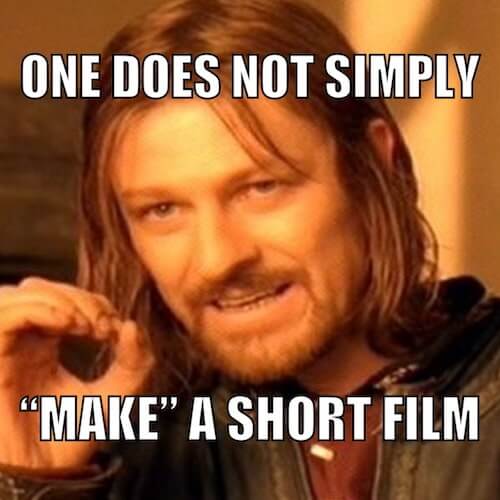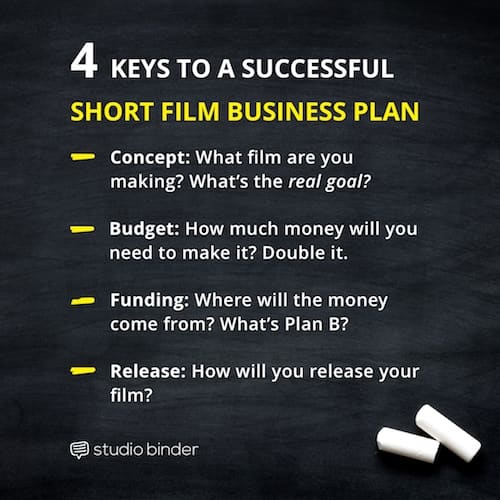Y
ou’ve got an awesome concept for a short film. Congratulations! Now you need a short film business plan.
Perhaps your idea just came to you out of the blue, perhaps you’ve developed it with my systematic process. Either way, you want to know what the first step towards turning your idea into an actual movie is.
Well, it’s not one step. It’s four.
4-Part Film Business Plan That Gets You Funding
There’s No Such Thing as a “Short Film Business Plan”
But that doesn’t mean you shouldn’t prepare one!
The term “Business Plan” comes out of the corporate world. It refers to a document that is prepared before a business launches.

Short Film Business Plan - Boromir - StudioBinder
- The document describes what the business will do, how it will do it, how much money it needs, and how it expects to recoup that money.
Business plans are shown to investors to help them determine whether or not to invest in a company. They are also useful guides for new employees to understand the company’s mission and purpose.
Your short films ideas generally won’t make money. That’s not typically their purpose. But that doesn’t mean that the content of a short film business plan isn’t an important part of how to make a short film!
It can: - Clarify your purpose, define your process and articulate your film’s potential.
- Inspire donors, supporters or high-value collaborators to join the project.
- Communicate your film’s purpose to your cast and crew, to make sure you’re all working towards a common goal.
- Define the film’s marketing angle, to inspire festivals to screen it or to inspire audiences to check it out.
Most importantly, defining your plan will give you the framework and focus to make sure you keep yourself on-track.
4-PART FILM BUSINESS PLAN THAT GETS YOU FUNDING
Don’t Plan the Oscar Party Yet!
We’re all dreamers in this business - how can we be anything else? But as tempting as the dreams of success and creative freedom may be, we’ve got to remember to take the first steps first.
A few years ago, I wrote a short film and got very excited about casting it.
There was a perfect role in the film for an old legend - an actor in his 80s or 90s. Perhaps an Oscar winner, someone who was once a luminary in Hollywood, but who’s probably not very busy anymore.
I spent my time thinking of great actors. The ones who starred in the classic films that I loved as a kid. I looked up which of them might still be alive and willing to work for a day.
It was thrilling to imagine directing these men… but did I ever make that film?
Nope.
You see, I skipped a vital step. I never really worked through the “film business plan” - the part of development where a producer figures out how and why the film will attract funding, and how and where it will reach its audience.
So what’s the first step? Let’s take a look at the big picture first.
4-PART FILM BUSINESS PLAN THAT GETS YOU FUNDING
What Are The Pieces of a Film Production Business Plan?
Your plan should consist of these four pieces:

Short Film Business Plan - 4 Keys - StudioBinder
Before we dive into these sections individually, there’s something important we need to understand that will tie them all together.
All of the pieces of your short film’s business plan connect in some way to your target market.
TARGET MARKET
Your target market is the audience (or audiences) that are most likely to seek out and enjoy your film.
A film about bullying might target high-school-age YouTubers (a demographic group, defined by age).
On the other hand, a film that takes place on a spaceship as it approaches an alien planet might target the sci-fi market (not a demographic group, but an interest group).
While a film about a gay Jewish boxer might have several simultaneous target markets.
- Jewish (a religious group)
- LGBT (a cause-oriented group, but also a group defined by lifestyle and social structure)
- Sports (an interest group)
In that last case, it’s helpful to know which is the dominant audience for the film. Is it more of a Jewish film? More of an LGBT-themed film? More of a sports film?
It’s also useful to understand where and how the markets intersect. There are many active Jewish LGBT organizations - not nearly as many Jewish/sports organizations.
If you’ve selected one your short film ideas with your target market in mind, this step will be easy.
If not, you’ve got to answer the following question:
What audience group is most likely to show interest in this film?
Once you know who you’re making your movie for, you can develop a specific strategy for crafting a film for them. And here’s the magical secret of this process:
The money and resources for your film will come from a subset of your target market.

This individual is key to many a short film business plan.
- What film are you making (for your target market)? What short film ideas appeal to them?
- How much money do you need (to pay for the elements that your target market will expect)?
- Where (from within your target market) will you raise funds or gather resources?
- How will you release your film (so your target market can see it)?
Once you know your target market, you can get specific about the elements of your short film business plan:
A SIDEBAR ON THE “ISSUE” FILM
If you’re making a film with a particular social or political cause, you might want your film to reach an audience that isn’t a natural fit.
Let’s say one of your film ideas would shed light on the plight of the Yazidi people who are facing severe persecution in parts of the Middle East. That’s essentially your logline.
The Yazidi already know this story - they aren’t your target audience.
But the people who you’re trying to influence, perhaps middle-class American voters, might not have a natural interest in the story. So how can you interest them in your film?
The answer can be hard to do, but it’s pretty straightforward:
Define your film for your target market.
This hypothetical film’s logline is “a film to shed light on the plight of the Yazidi people”. The logline could also be “a harrowing tale of survival in an exotic and faraway land”.
One description is very specific to people who know and care about the Yazidi situation. The other might appeal to a much broader audience.
If your intended audience doesn't match your subject matter, you need to make sure that you can frame the film in a way that appeals to them.
If you don’t, your film will never reach the people it was made for.
Now we can get into the details of your short film business plan.
4-PART FILM BUSINESS PLAN THAT GETS YOU FUNDING
A Film Synopsis for Your Target Market
Whether you’re working off of a written screenplay, or you have yet to commission a screenwriter, you already know the story of your film. Before you can get into the details of your short film business plan, you need to lay out the story, as you expect it to be told, for others.
There are lots of definitions and “rules” when it comes to writing a feature film synopsis, especially if you plan to use it to pitch or promote your film.
But since we’re creating a short film business plan, you might be reassured to remember that there are no rules here.
That said, the purpose of this business plan may help guide you in terms of short film ideas to work on.
- The business plan is your personal tool to help keep you focused as you shepherd this short film from development through its release.
- Your synopsis should be focused. Tell the skeleton of the story. Don’t go into detail.
- It’s your communications tool, to help describe the project to potential supporters and collaborators.
- Keep the synopsis short. A 3-5 sentence paragraph might suffice. A logline might be better
Make sure your logline is written with your target market in mind.
Remember: The money and resources for your film will come from a subset of your target market.
You want people in your target market to respond, “wow, it’s like this short film is being made just for me!”

Appealing to the egotism of others: also key to a short film business plan.
In some cases, a synopsis or logline is enough of a description of the project to give people a clear sense of what you’re trying to accomplish.
IF IT LOOKS IMPOSSIBLE, ADDRESS THE IMPOSSIBILITY
Sometimes, it may be worthwhile to write a paragraph or two describing the strategy behind the film production.
This is especially true if there are elements in the logline of the that might make people skeptical of your ability to pull it off.
When I began to raise money for “The Pirate Captain Toledano”, the first and obvious question that everyone asked was “how will you shoot this film? It’s set on a pirate ship!”
It was important to preempt that question by explaining that I had already negotiated for not one, but two tall ships where the film could be shot.

Remember this from my first article?
If your film is set in a hard-to-secure location or features elements that are typically expensive or hard to find, write a paragraph or two explaining how you plan to tackle those challenges.
4-PART FILM BUSINESS PLAN THAT GETS YOU FUNDING
The Roadmap and Compass of your Film Production
If you don’t tell people what you need, they won’t know how to help you. And if you don’t tell them when you need it, they won’t help you soon enough.
That’s why you need to prepare a preliminary production schedule and a rough budget for your short film project.
At this stage, your production schedule and budget are very speculative. You might not even have a script yet!
That's alright.
SHORT FILM SCHEDULING
You’ve got to put some dates down on a calendar, and some figures down in a spreadsheet. They’ll shift and change, of course, but this starting point will anchor you as the project develops.
For your preliminary schedule, you should look at two factors:
- When will production happen?
- How long will production last?
For the first, consider how long it will take you to raise money, assemble a team and line up all the bits and pieces before production can get started.
If you’re a veteran producer, you’ve done all of this before, and can probably estimate the timetable pretty well. If you’re relatively new, consider this guide to the pre-production process.
It’s written with feature films in mind, so you should be able to take each of those stages and shorten it quite a bit for how to make a short film.
Look at the calendar and pick a reasonable shoot date. It can be vague, too - “we’re aiming to shoot the film in December”.
Just make sure to give yourself enough time to get everything ready!
Don't worry too much if it takes a little longer to raise money. You usually have a lot of flexibility with the shoot date until you start booking locations, cast, crew and equipment.
The exception, of course, is seasonal. If your short film ideas require you to shoot in a snowy field in North Dakota, you can’t push production to July.
PRODUCTION SCHEDULING
The second factor you should look at is the duration of production. If you have a script, you may want to do a preliminary script breakdown and use that to generate a stripboard and schedule.
Software like StudioBinder, Gorilla, and MovieMagic can streamline that process.
But at this early stage, a paper napkin schedule may suffice for your script breakdown.
Other articles on StudioBinder can offer you guidance on screenplay scheduling. We even have a video on the subject that you may find helpful.
Starring none other than yours truly!
Even if you don’t have a screenplay yet, you should still have a sense of whether your film can be shot in a day or if it requires a full week.
Again, this can shift and change as your project evolves. You need some starting definitions of your plan and your needs so you can communicate them.
Armed with a preliminary schedule, you can then pull together a rough film budget for the project.
SHORT FILM BUDGETING
This budget won’t be detailed. That’s okay. In fact, it might be just a budget top sheet.
All you need to know now is the ballpark cost of your project so that you know how much money you need to raise, or how much support you need to inspire.
If you’ve selected your short film concept carefully, you probably have a sense already of how much it’ll cost to pull off. At the very least, you have a sense of how much money you’ll be able to raise for it.
If that’s the case, you might find yourself ‘backing-into’ the film budget. Starting with a bottom-line figure, and massaging the numbers to make them fit that bottom-line.
If you're an experienced producer, you may not need as much detail in your preliminary budget. Your experience will guide you for how much your major budget categories will cost.
But if you’re still new to this, I advise you to take the extra time to budget in more detail.
You only need the top-sheet for your short film business plan. However, the more you familiarize yourself with the details of your budget, the more control you’ll have over it.
Once again, an understanding of your target market will help you here.
If there are certain personalities that your target market responds to, consider setting aside money to hire them.
Are there certain details in the production that your target market would expect to see? Account for them.
Does your target market only read a specific newspaper on Tuesdays? Make sure you’ve budgeted for a full-page ad in the Tuesday edition.

I say, have you heard about this short film?
4-PART FILM BUSINESS PLAN THAT GETS YOU FUNDING
Funding your Short Film: Which Tree to Shake?
You’ve described your film, set a target shoot date, and prepared a preliminary schedule and a film budget. Now you have a valuable piece of information: How much money you need to pull this off!
There are several ways that filmmakers commonly raise money for short films. Pick a method (or a combination of methods) that works for you, and take a page to describe how you’ll go about it.
Will you run a crowdfunding campaign? Solicit direct contributions from friends and family? Try to get an “investor”? Fund the film yourself?
Whatever fundraising method you choose, go into detail on your strategy. Crowdfunding, in particular, requires rigorous preparation.
An important piece of this process is connecting your fundraising strategy to your target market.
Remember: The money and resources for your film will come from a subset of your target market.
So, who do you know in your target market? What organizations will you connect with? Who in your target market is most likely not just to enjoy the film, but to contribute to its success?
Are there people in your target market who are also in the film industry? Might they be potential collaborators on your short film?
Figure out your strategy, and boil it down to a page.
4-PART FILM BUSINESS PLAN THAT GETS YOU FUNDING
Film Distribution: A Plan for Connecting Your Film to its Audience
The final piece of your short film business plan is your release strategy. How will you bring your film to the attention of your target market?
Most filmmakers make their shorts without much thought for distribution. As a result, most short films are barely seen by anyone.
People who might consider supporting or joining your short film are more likely to do so if they feel that the project has a strong chance of actually connecting with its audience.
Once again, understanding your target market is critical here. Where do they see short films? Festivals? YouTube? In-flight movies?

In-flight movies might not be the best idea for your short film business plan, as it is not the
Wherever they consume this type of media, you’ve got to figure out what it takes to get your film there.
In most cases, your rollout strategy will consist of several steps or stages. For example:
You might want your film available for purchase on Amazon Streaming (through Amazon Video Direct).
Maybe you've discovered that your target market seeks out films like yours only if they’ve been covered in certain newspapers, magazines, or blogs.
Look at those publications, and you might find that they only cover short films that appear at certain film festivals.
You now have a film distribution strategy. Start with certain festivals. Combine it with a PR push to specific publications. Finish with a rollout to Amazon Streaming.
Maybe you’re creating a proof-of-concept or a calling card film. Then, your target market is agents, managers, producers and other decision-makers in the industry.
Your choice of festival submissions, screening venues, and the final online platform would be quite different in this case.
Whether you define your release strategy in an outline, a paragraph or two, or a flow chart, make sure you put it down on the page so it can be communicated.
4-PART FILM BUSINESS PLAN THAT GETS YOU FUNDING
The Short Film Business Plan: Your Communication Tool
Ultimately, your short film business plan is a communications tool, so make sure it says what you want it to say.
Keep it honest. Don’t put down budget numbers that you don’t believe (even if you think they might impress someone!)
Don’t describe the film in a way you can’t relate to (even if you think that’s what your audience will want to hear).
Add graphics, charts, whatever you need in order to communicate what you need to communicate.
In the end, it’s possible no one will see your business plan. It could be just a tool for you, a method of framing up the entire filmmaking process in your mind.
Even if no one else sees this document, it will be of tremendous value in helping you stay on track.
If you put something like this together for your next short film, please let me know how it goes! If you’re still looking for more short film ideas, check out the first post in my short film series.
Break a lens!
